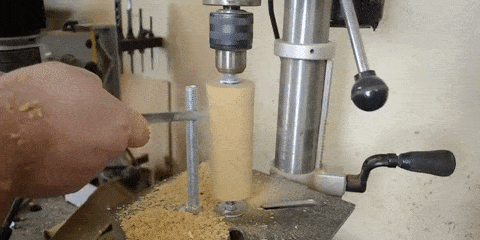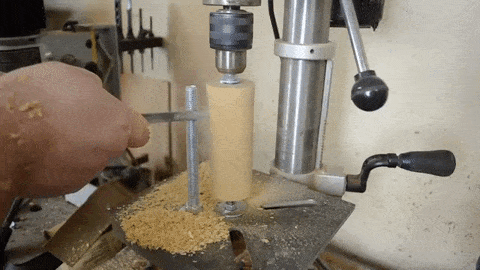Can a drill press be used as a lathe? If you’ve ever wondered about this, you’re in the right place! Here, we’ll explore the exciting world of workshop tools to see if a drill press can double as a lathe. So, grab your safety goggles and let’s dive right in!
Now, I know what you’re thinking. “What’s a drill press, and what’s a lathe?” Well, my curious friend, a drill press is a nifty tool that helps you make precise holes in materials like wood or metal. On the other hand, a lathe is a machine used to shape and mold objects by rotating them against a cutting tool.
You may be wondering if you can get creative and use your drill press as a lathe. It sounds intriguing, doesn’t it? But before we get into the details, let’s explore if it’s a possibility or just wishful thinking. So, stick around, and let’s find out together!

Can a Drill Press Be Used as a Lathe?
Drill presses and lathes are both essential tools in a workshop, but can a drill press be used as a lathe? In this article, we will explore the possibilities and limitations of using a drill press as a lathe. We will discuss the key differences between the two tools, the techniques and modifications required to convert a drill press into a makeshift lathe, and the potential applications and benefits of using a drill press in this manner. Whether you are a hobbyist or a professional woodworker, this article will provide insights into the feasibility of using a drill press as a lathe and help you make an informed decision.
Understanding the Differences
Before we delve into the concept of using a drill press as a lathe, it is crucial to understand the fundamental differences between the two tools. A drill press is primarily used for creating holes in different materials, while a lathe is designed for rotational shaping and cutting. The primary function of a drill press is to drill vertically through a workpiece with significant precision, whereas a lathe enables you to rotate a workpiece horizontally to shape it symmetrically.
While both tools involve rotational motion, a drill press lacks the key features necessary for effective lathe work. A drill press typically lacks a tool rest, a means to securely hold the workpiece in place, and a mechanism to control the rotation speed. These features are essential for safe and efficient lathe work, which brings us to the question of using a drill press as a lathe.
Modifications and Techniques
Converting a drill press into a lathe requires several modifications and techniques to ensure safe and accurate operation. While this makeshift approach may not match the capabilities and precision of a dedicated lathe, it can serve as a viable solution for certain applications.
Firstly, you will need to attach a tool rest to the drill press. This can be accomplished by fabricating a custom tool rest from sturdy materials and securely attaching it to the drill press table. The tool rest provides stability and support for the cutting tool while shaping the workpiece.
Secondly, you will need a method to hold the workpiece securely. This can be achieved by utilizing a chuck or a faceplate that can be attached to the spindle of the drill press. These attachments allow you to clamp and secure the workpiece in place, ensuring stability during the turning process.
Potential Applications and Benefits
While using a drill press as a lathe may be considered unconventional, it can still offer various benefits and applications. This makeshift setup can be useful for small-scale turning projects, such as crafting wooden pens, small bowls, or intricate spindle work.
One of the advantages of using a drill press as a lathe is cost-effectiveness. If you already own a drill press, you can repurpose it to perform basic lathe functions without having to invest in an additional machine. This can be particularly beneficial for hobbyists or those with limited workshop space and budget.
Furthermore, using a drill press as a lathe allows for increased versatility in a workshop. You can switch between drilling and lathe work without the need for separate machines, saving time and space. It also provides an opportunity to experiment and explore different techniques and projects that incorporate both drilling and shaping processes.
Tips for Using a Drill Press as a Lathe
If you decide to use a drill press as a lathe, it is important to keep certain tips in mind to ensure safety and optimal results:
- Wear appropriate safety gear, including protective goggles and gloves.
- Always secure the workpiece firmly using clamps or chucks to avoid any movement or instability.
- Start with lighter cuts and gradually increase the depth and complexity of the turning projects.
- Keep the tool rest close to the workpiece and maintain a steady hand while shaping the material.
- Regularly check the stability and alignment of the drill press setup to prevent any accidents or misalignments.
Conclusion
While a drill press can be used as a lathe with the necessary modifications and precautions, it is important to note that it will not offer the same level of precision and capabilities as a dedicated lathe. However, for certain small-scale turning projects and hobbyist applications, using a drill press as a lathe can be a cost-effective and space-saving solution. Always prioritize safety and follow best practices when using any tool in unconventional ways. Now that you have a better understanding of using a drill press as a lathe, you can explore the opportunities it presents and unleash your creativity in the workshop.
Can a Drill Press be Used as a Lathe? – Key Takeaways
- Using a drill press as a lathe is not recommended because they have different designs and purposes.
- A drill press is designed for vertical drilling, while a lathe is used for rotating and shaping materials.
- Attempting to use a drill press as a lathe can be dangerous and may result in damage to the equipment or injury to the user.
- If you need to perform lathe-like functions, it is best to invest in a lathe specifically designed for that purpose.
- Always use equipment as intended and follow safety guidelines to ensure a successful and safe woodworking experience.
Frequently Asked Questions
Are you wondering if a drill press can be used as a lathe? Look no further! We’ve got the answers to your burning questions about this topic.
1. Can a drill press be used to turn wood or metal like a lathe?
No, a drill press cannot be used as a lathe for turning wood or metal. While both tools involve rotating workpieces, they serve different purposes. A drill press is primarily designed for drilling holes, using a vertical motion, and is not equipped with the necessary components or features for turning or shaping materials like a lathe. Attempting to use a drill press as a lathe can lead to safety hazards and damage to both the equipment and the workpiece.
If you’re interested in turning wood or metal, it’s best to invest in a lathe specifically designed for that purpose. A lathe provides a stable and controlled platform for spinning the workpiece while allowing you to shape and cut it precisely. It offers versatility, features, and safety mechanisms specifically engineered for the art of turning.
2. Are there any attachments or modifications that can turn a drill press into a lathe?
While there may be some aftermarket attachments or modifications available in the market that claim to transform a drill press into a makeshift lathe, it’s important to approach these options with caution. These attachments or modifications might not provide the necessary rigidity or stability required for safe and accurate turning operations.
Moreover, utilizing a drill press as a lathe through attachments or modifications can void the warranty of the equipment and may compromise user safety. It’s essential to follow the manufacturer’s guidelines and use equipment for its intended purpose to ensure optimal performance and avoid any potential hazards. If you’re interested in turning operations, investing in a proper lathe will yield better results in terms of safety, precision, and overall performance.
3. Can a drill press be used for drilling holes in a workpiece before using a lathe?
Yes, using a drill press to pre-drill holes in a workpiece before using a lathe is a common practice. Pre-drilling holes can help provide more stability and precision while mounting the workpiece on the lathe. By drilling holes prior to turning, you can ensure proper alignment and secure the workpiece firmly in place, reducing the chances of it slipping or moving during the turning process.
Using a drill press for pre-drilling holes allows you to achieve consistent hole sizes and helps in aligning the turning centers accurately. This technique is commonly employed in woodworking projects and can be beneficial for precise and clean hole drilling before moving on to the lathe for turning or shaping the workpiece.
4. What are some safety considerations when using a drill press or lathe?
When operating a drill press or lathe, safety should always be a top priority. Some essential safety considerations include:
1. Wearing appropriate personal protective equipment (PPE) such as safety glasses and hearing protection.
2. Ensuring the workpiece is securely fastened and supported to prevent movement or kickback.
3. Keeping long hair, loose clothing, and jewelry away from rotating parts.
4. Using sharp and well-maintained tools to minimize the risk of accidents.
5. Understanding and following the manufacturer’s instructions and safety guidelines for the specific tools being used.
By following these safety precautions and using these tools responsibly, you can minimize the risk of accidents and injuries while working with a drill press or lathe.
5. Can a drill press and a lathe be used together in a woodworking or metalworking project?
Yes, a drill press and a lathe can be used together in woodworking or metalworking projects to achieve different tasks. For example, you may use a drill press to create holes in a workpiece and then mount that piece on a lathe to turn or shape it. The drill press provides accuracy and control for drilling precise holes, while the lathe offers the ability to shape and refine the workpiece in a more intricate and detailed manner.
By combining the capabilities of a drill press and a lathe, you can enhance your woodworking or metalworking projects and achieve a broader range of possibilities. Understanding how to leverage the unique features of each tool and using them in harmony can lead to impressive results in various projects.

Summary
So, can you use a drill press as a lathe? Well, although it might seem like a good idea, the answer is no. While a drill press and a lathe may have similar functions, they are designed differently. A drill press is for making holes, while a lathe is for turning and shaping wood or metal. Using a drill press as a lathe can be dangerous and might not give you the desired results. It’s always best to use tools for their intended purposes to ensure safety and success in your projects.
If you’re interested in trying out lathe work, it’s recommended to invest in a lathe machine. A lathe will provide the necessary control and precision for turning projects. Different lathe models are available, so you can choose one that suits your needs and budget. Remember to follow safety guidelines and practice proper techniques when using any tools to enjoy a successful and safe woodworking experience.
